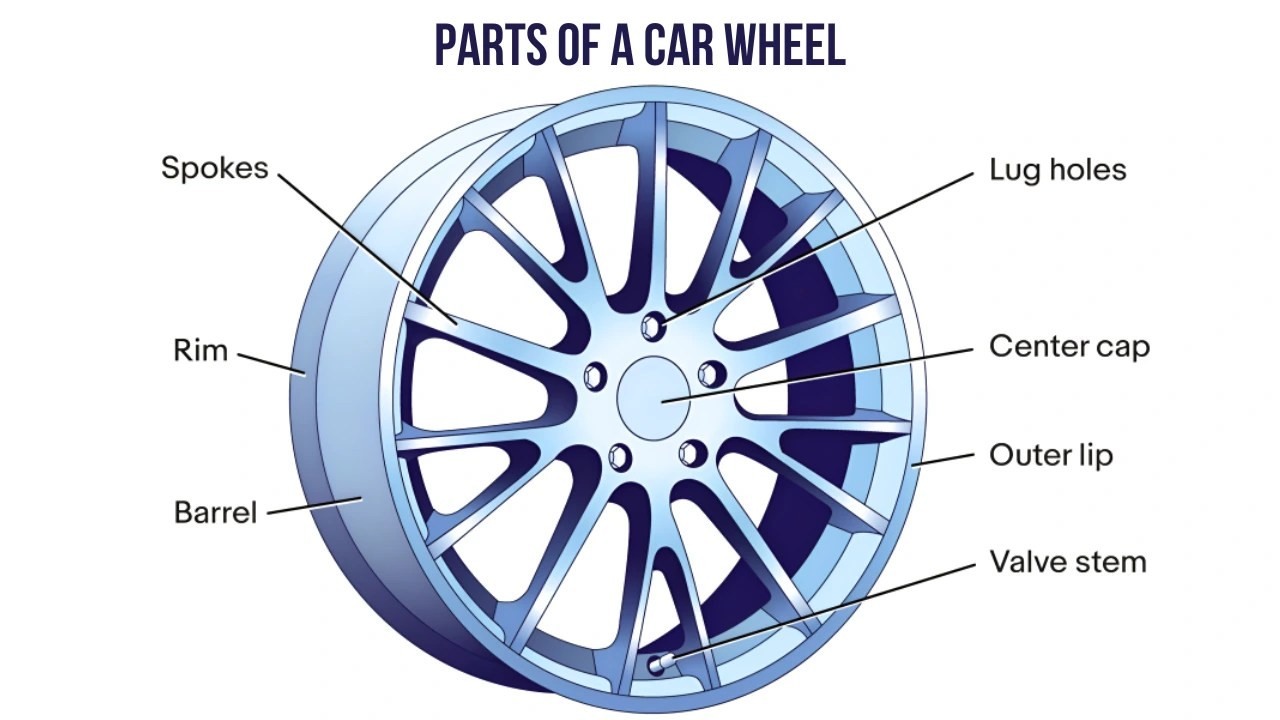From the everyday commuter to high-performance sports cars, the wheel is an indispensable component. It’s hard to imagine modern transportation without this fundamental invention, arguably as crucial as fire in human history. Wheels, in conjunction with tires, are what allow vehicles to move, carry loads, and provide a comfortable ride. While the core function remains consistent across all vehicles, the design, size, and materials can vary significantly.
To deepen your automotive knowledge and enhance your car maintenance skills, understanding the Parts Of A Car Wheel is essential. Familiarity with these components empowers you to better care for your vehicle and ensure its longevity and optimal performance. Let’s delve into the anatomy of a car wheel and explore each part in detail.
 Diagram of Car Wheel Parts with Labels
Diagram of Car Wheel Parts with Labels
Essential Components of a Car Wheel
A car wheel is more than just a simple circular object; it’s a complex assembly of different parts working in harmony. We can broadly categorize the main parts into three primary components: the tire, the rim, and the hub.
#1. The Tire: The Vehicle’s Contact Point with the Road
The tire is arguably the most recognized part of the wheel. It’s the rubber component that encircles the rim and provides the crucial contact between your vehicle and the road surface. Modern tires are pneumatic, meaning they are filled with air, which provides cushioning and a smoother ride compared to older solid rubber tires.
Tires are critical for:
- Ride Comfort: The air within the tire absorbs shocks from road imperfections, leading to a more comfortable driving experience.
- Grip and Traction: Tire tread patterns are designed to maximize grip on various road surfaces, including wet, dry, and even snowy or icy conditions. Proper tire selection is vital for safety and handling.
- Load Bearing: Tires are engineered to support the weight of the vehicle and its load.
- Braking and Handling: Tires play a crucial role in braking and steering responsiveness.
Choosing the right type of tire, maintaining proper tire pressure, and ensuring adequate tread depth are paramount for vehicle safety and performance.
#2. The Rim: The Wheel’s Structural Foundation
If the tire is the skin of the wheel assembly, then the rim is its skeleton. The rim is the metal structure that the tire is mounted onto. It provides the shape and support for the tire, allowing it to hold air and maintain its form.
Rims are typically constructed from:
- Steel: Steel rims are durable and more affordable, commonly found on standard vehicles. They are heavier than aluminum rims.
- Aluminum Alloy: Alloy rims are lighter than steel, which can improve fuel efficiency and handling. They also offer greater design flexibility and are often chosen for their aesthetic appeal.
Rims come in a vast array of styles, finishes, and sizes. Trucks, for example, often utilize heavier-duty rims to withstand greater loads and tougher conditions, prioritizing function over purely cosmetic design. The diameter and width of the rim dictate the compatible tire size and style.
#3. The Hub: Connecting the Wheel to the Vehicle
The hub is the central part of the wheel assembly that connects the wheel to the vehicle’s axle. It’s the interface point where the wheel rotates around the axle, enabling movement. The hub is also a critical area for other vital vehicle components.
The hub area commonly houses:
- Brake Components: Brake rotors, calipers, and pads are often mounted to the hub assembly, allowing for effective braking.
- Wheel Bearings: These bearings allow the wheel to rotate smoothly and with minimal friction around the axle.
- Wheel Studs or Bolts: These fasteners, along with lug nuts or bolts, secure the wheel to the hub.
The hub is essential for both vehicle motion and stopping power, making its integrity crucial for safety and vehicle operation.
Deeper Dive: Further Parts of a Car Wheel
Beyond the main components, several other parts contribute to the functionality and integrity of a car wheel.
#4. Spokes: Structural and Aesthetic Elements
Spokes are the structural elements that radiate outwards from the central hub to connect with the rim. They provide significant structural integrity to the wheel, distributing load and impact forces. Along with the hub, spokes form the visible face of the wheel.
Spokes also play a major role in wheel aesthetics. Custom wheel designs often feature diverse spoke styles, varying in:
- Number: From a few thick spokes to many thin spokes.
- Width: Wide, robust spokes or slender, delicate spokes.
- Shape: Straight, curved, twisted, or uniquely shaped spokes.
- Pattern: Radial, mesh, directional, and other patterns.
While five-spoke wheels are a common and structurally sound design, the number of spokes generally has a minimal impact on performance compared to factors like material and construction. Wheel choice often comes down to personal preference and visual appeal.
#5. Outer Lip (Dish): Primarily for Aesthetics
The outer lip, sometimes referred to as the dish, is the area of the wheel that extends outwards from the spokes towards the outer edge of the rim. The “dish” becomes prominent when the spokes are set back significantly from the outer edge, creating a “deep-dish” wheel appearance.
The depth of the outer lip is primarily an aesthetic consideration. While deep-dish wheels can enhance a vehicle’s visual style, an excessively deep dish can make the wheel face more susceptible to damage from impacts.
#6. Barrel: The Tire Mounting Structure
The barrel is the outermost cylindrical portion of the wheel rim. It’s the structure specifically designed for mounting the tire. The barrel incorporates several key features:
- Drop Center: The narrowest diameter of the barrel, facilitating tire mounting and removal without overstretching the tire bead wires.
- Flanges: Flared edges at the barrel’s edges that extend outwards. These flanges are crucial for retaining the tire and preventing it from slipping off the rim, particularly under cornering forces.
Depending on the location of the drop center, wheels can be classified as:
- Front Mount Wheel: Drop center is closer to the front face of the wheel.
- Reverse Mount Wheel: Drop center is closer to the back face of the wheel.
#7. Beads: Tire-Rim Sealing Surface
Located just inside the flanges are the beads. These are flat, precisely shaped areas on the barrel where the edges (beads) of the tire seat against the rim. The beads form an airtight seal between the tire and the rim, essential for maintaining tire pressure.
#8. Flanges: Tire Retention Edges
Flanges are the flared edges along both the inboard (towards the vehicle) and outboard (away from the vehicle) sides of the rim barrel. Their primary function is to prevent the tire from rolling off the rim, especially during cornering or in the event of a sudden loss of tire pressure.
#9. Mounting Humps: Bead Slippage Prevention
Mounting humps are small ridges that run circumferentially along the inside of each bead seat. These humps act as an additional safety feature to prevent the tire beads from slipping inwards towards the drop center, further securing the tire’s position on the rim.
#10. Drop Center: Tire Mounting Assistance
The drop center, as mentioned earlier, is the narrowest part of the barrel’s diameter. This recessed area is designed to make tire mounting and demounting easier. It provides the necessary clearance to manipulate the tire bead over the rim flanges during installation and removal.
#11. Center Cap: Hub Cover and Protection
The center cap is a removable cover that fits over the center bore on the outboard side of the wheel. It serves both aesthetic and protective purposes.
- Aesthetic: Center caps can enhance the wheel’s appearance and often feature manufacturer logos or branding.
- Protective: Center caps can protect the wheel hub and, in some cases, the lug nuts from dirt, debris, and corrosion.
#12. Valve Stem: Inflation and Pressure Monitoring
The valve stem is a small, typically metal, valve that protrudes through a hole in the rim. It’s the access point for inflating the tire with air. Modern valve stems can also integrate with Tire Pressure Monitoring Systems (TPMS) to provide real-time tire pressure readings to the driver. A valve stem cap is used to protect the valve core from dirt and debris and to provide a secondary air seal.
FAQs About Car Wheel Parts
What are the Main Parts of a Car Wheel?
The primary parts of a car wheel are the tire, the rim, and the hub. The tire provides road contact, the rim supports the tire, and the hub connects the wheel to the vehicle.
What is the Part of the Car Body Above the Wheel Called?
The part of the car body directly above the wheel is called the fender or wheel arch. Fenders protect the vehicle and pedestrians from debris thrown up by the tires and contribute to the vehicle’s aerodynamics.
What Fastens a Wheel to a Car?
Wheels are typically fastened to the car using wheel studs or wheel bolts and lug nuts or wheel bolts. Wheel studs are permanently fixed to the hub, and lug nuts are tightened onto them to secure the wheel. Some vehicles use wheel bolts that thread directly into the hub.
What are the Core Components Inside a Car Wheel?
Internally, a car wheel assembly includes components like wheel bearings (allowing smooth rotation), brake rotors, brake calipers, and brake pads (for braking), all often integrated within or around the hub area.
Understanding the intricate parts of a car wheel empowers you to appreciate the engineering behind this essential automotive component. This knowledge not only enhances your general car expertise but also aids in better vehicle maintenance and informed decision-making regarding wheel and tire care.
